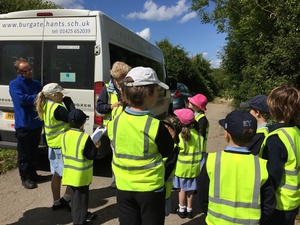
Breamore buzzing
Published on 2015-06-09 by Gill Hickman
Breamore Primary School’s Science Ambassadors were among the first local school children to visit West Solent Solar Cooperative solar farm. This unobtrusive 2.4MWp solar farm hides behind hedgerows in Pennington where it quietly reduces our carbon emissions, boosts local biodiversity and enhances the UK’s energy security. And it’s not just a solar farm; it’s a cooperative solar farm, one that is owned by the community. This visit was highly appropriate for young science ambassadors, a visit where their learning was enhanced and children’s thinking stretched.
Children rose to the challenge as learning in the filed began. After a safety briefing they were whisked onto the site which they heard was a former gravel pit which had later been used for landfill, perfect for a solar farm. They learnt about the solar photovoltaic (PV) effect that was first discovered in 1839: Solar Century, the contractors chosen for installation, have been kind to schools and arranged for a child height model solar panel to be linked to a meter. Cathy Cook explained how atoms became excited and soon had children jiggling. She then demonstrated how less power was generated when she blocked out the sun over the panel.
Children heard that solar equipment covers just 28% of the area of the field. The land between the solar panels has been planted with a mix of wildflowers and grass although wildflowers are not very abundant yet. Children were taken onto an observation mound that had been created from spoil a year ago, and there they had a great view over the entire solar farm. Almost all of the 9372 solar panels were visible. This mound had also been seeded by Hampshire and Isle of Wight Wildlife trust and success was evident. Species such as Vetch, Poppy, Buttercup, Echium, Chamomile and Birds Foot Trefoil, had been carefully chosen to ensure maximum benefit for wildlife.
The young scientists left the mound to inspect an inverter, a device that converts DC current into AC, and this was a difficult concept for children to grasp! They learnt that inverters gather the electricity generated by a large number of solar panels and that distribution boards take power from the inverters. Finally a transformer takes all electricity from the distribution boards converting it from low voltage to high voltage. Cables get fatter at each successive stage with fattest going into the substation. Solar Century had provided cables of all diameters for the children to inspect. The fattest cable was impressively heavy.
More science was to come! There was time for discussion: why was electricity from the sun so important? Most children were aware of the need to reduce man-made carbon dioxide in the atmosphere, and these discussions are so important. They learnt that 'renewable' means that the energy won’t run out, unlike coal, oil and gas which will. We hope children will remember this when they are taking their GCSE science exams! Children were shown the cables that take electricity into the National Grid at 11kV. The function of pyranometers, security cameras and a satellite dish were explained, and the youngsters learnt how internet and global communications rely on solar-powered satellites orbiting the Earth.
The youngsters were blessed with some early summer sunshine although temperature was tempered by a chill wind. These were perfect conditions to illustrate the point that heat is unimportant. It is the solar flux that counts and the sunny conditions of the June morning meant that the solar farm was generating nearly 2 megawatts of electricity, enough to boil about 700 kettles, or to power around two million mobile phone chargers. The young scientists listened to the buzzing of the inverters and could believe electricity was being made from the sun!
Before returning to their minibus, children were shown the trees planted by Lymington Transition volunteers. They had been donated by the Woodland Trust and again the young ambassadors learnt that this would provide habitat for insects, spiders, birds and mammals. West Solent Solar Community Cooperative was the brainchild of Anthony Woolhouse. He is also a beekeeper, and children enjoyed spotting the beehives he has installed on site. There are already sufficient wildflowers to meet the needs of the buzzing pollinators.
The output performance figures for the solar farm can now be viewed live online and this means that the science can very definitely be taken back to school and shared with others. This is important to the school that is working hard, and with great success, towards highly sustainable practice. The young Science Ambassadors loved their visit and it is to the credit of their school and their teacher Abigail Clamp that they understood so much. What, she asked, was the best part of the visit? The response was almost unanimous: when the sun disappeared behind a cloud, the buzzing of the inverters suddenly stopped. Scientific magic!
